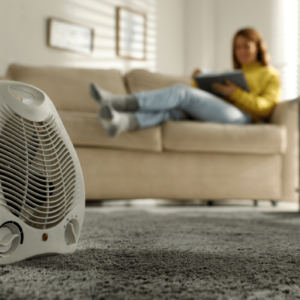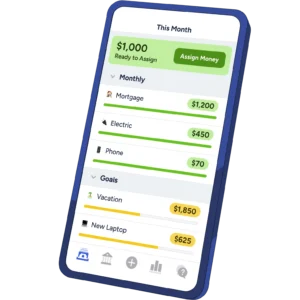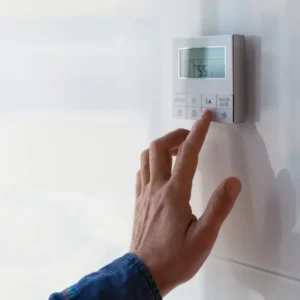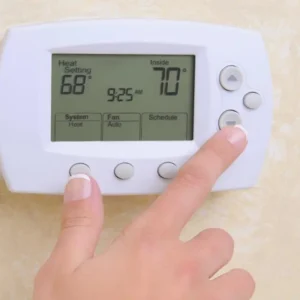Is there a perfect AC temperature for saving money without sacrificing comfort? What temperature should you set your thermostat to during summer and winter? How can you cut down on energy bills while keeping your space comfortable?
If you’ve ever asked these questions, you’re not alone. In the USA and the UK, where seasonal temperature shifts are real and energy prices keep climbing, finding that sweet spot for your thermostat isn’t just a luxury—it’s a necessity. This guide breaks it all down in a simple, practical way that helps you save money, stay comfortable, and make smart energy decisions at home.
The Energy Dilemma: Comfort vs. Cost
Heating and cooling your home takes up a massive chunk of your utility bills. According to the U.S. Department of Energy, air conditioning accounts for about 12% of total household energy expenditures in the U.S. In the UK, energy prices surged by nearly 80% in 2022, with heating and cooling being major culprits. So what’s the best AC temperature for energy saving? Let’s dig in.
So, What Is the Best AC Temperature for Energy Saving?
The Department of Energy recommends setting your thermostat to 78°F (25.5°C) during summer when you’re at home.
Why? Because it’s a balance point—not too hot to be uncomfortable, and not too cool to cause a spike in your energy bill. In the winter, the ideal setting for heating is 68°F (20°C) when you’re awake and active at home.
When you’re away from home:
- Summer: Set it to 85°F (29°C)
- Winter: Lower it to 60°F (15.5°C)
Read Also: Best Temperature to Set the Thermostat in Winter to Save Money
These changes can save you up to 10% a year on heating and cooling costs.
Why It Works: The Science of Thermostat Settings
Your AC works harder the more drastic the temperature difference is between inside and outside. The closer your indoor setting is to the outdoor temperature, the less strain on your system and the less energy it uses.
For example, setting your AC at 72°F (22°C) when it’s 95°F (35°C) outside means your system works significantly harder than if you set it at 78°F (25.5°C).
Tips to Maximize Comfort While Saving Energy
1. Use a Programmable Thermostat
Invest in a smart thermostat like Nest, Hive, or Ecobee. These devices learn your schedule, adjust temperatures automatically, and can be controlled remotely. Perfect for busy households in both the USA and the UK.
2. Use Fans Strategically
Ceiling fans help circulate cool air. A fan can make a room feel up to 4°F cooler, allowing you to raise the thermostat without losing comfort.
3. Seal Leaks and Insulate
Drafty windows, uninsulated attics, and poor sealing can waste both heat and AC. Caulk and weather-strip where needed. Use thermal curtains in both hot and cold months.
4. Close Curtains and Blinds During the Day
Sunlight can heat a room fast. Keep blinds closed during the hottest part of the day to reduce indoor heat gain.
5. Use Zoned Cooling/Heating
If your system allows it, only cool or heat the rooms you’re using. There’s no point in cooling a guest room when no one is staying there.
USA vs. UK: Regional Considerations
United States
- Hotter summers, especially in the southern states.
- Homes are more likely to have central air conditioning.
- Power bills can skyrocket if the AC is not optimized.
Tip: If you’re in states like Texas, Florida, or Arizona, AC is non-negotiable. Use ceiling fans and smart thermostats to stay comfortable at 78°F.
United Kingdom
- AC use is increasing, but still not as common.
- Heat pumps and electric heating systems are widespread.
- Energy efficiency is essential due to higher energy tariffs.
Read Also: 10 Proven Ways to Save Money on the Gas Bill
Tip: In UK homes without AC, portable units are gaining popularity. Keep your units well-maintained, use them strategically, and insulate your home properly.
The 2-Degree Rule: A Simple Adjustment with Big Impact
Raise your AC setting by just 2 degrees in the summer and lower it by 2 degrees in the winter. You probably won’t feel much difference in comfort, but you will see a difference on your energy bill.
A 2°F increase in summer settings can save up to 6% in cooling costs. That adds up quickly across months.
Common Questions Answered
Q1: Is 72°F too cold in summer? Yes, it is cooler than recommended. Unless health concerns require it, consider adjusting it to 78°F.
Q2: Should I turn my AC off when I’m not home? Not completely. Instead, raise the temperature to 85°F. Turning it off makes the system work harder to cool the house down when you return.
Q3: Is sleeping at 78°F uncomfortable? It depends. Use a fan or light bedding. For some, 74°F with a fan is a better compromise.
Q4: What about humidity? High humidity makes heat feel worse. Use a dehumidifier or run the AC in dry mode to improve comfort.
Smart Tools That Can Help
- Nest Thermostat: Works with Google Home, learns your preferences, and saves energy.
- Hive Active Heating: Popular in the UK, works well with boilers and heat pumps.
- Ecobee: Works with sensors for room-by-room climate control.
- Thermal Curtains: Keep your room cool in summer and warm in winter.
Real-Life Energy Saving Examples
Case 1: A Family in Austin, Texas switched from 72°F to 78°F with ceiling fans. Saved $40/month on electric bills during summer.
Case 2: A Couple in Manchester, UK, used a portable AC set to 25°C, thermal blackout curtains, and a smart plug timer. Saved £60 over the summer quarter.
Final Thoughts: Small Changes, Big Savings
You don’t have to sacrifice comfort to save money. By simply adjusting your thermostat settings to the recommended 78°F in summer and 68°F in winter, and pairing those changes with smart tools and energy-conscious habits, you can dramatically lower your energy bills.
In both the USA and the UK, where energy costs are high and seasons are unpredictable, these practical tips empower you to take control of your comfort and your wallet.
So, check your thermostat today. Make a small change. Your energy bill (and your future self) will thank you.





